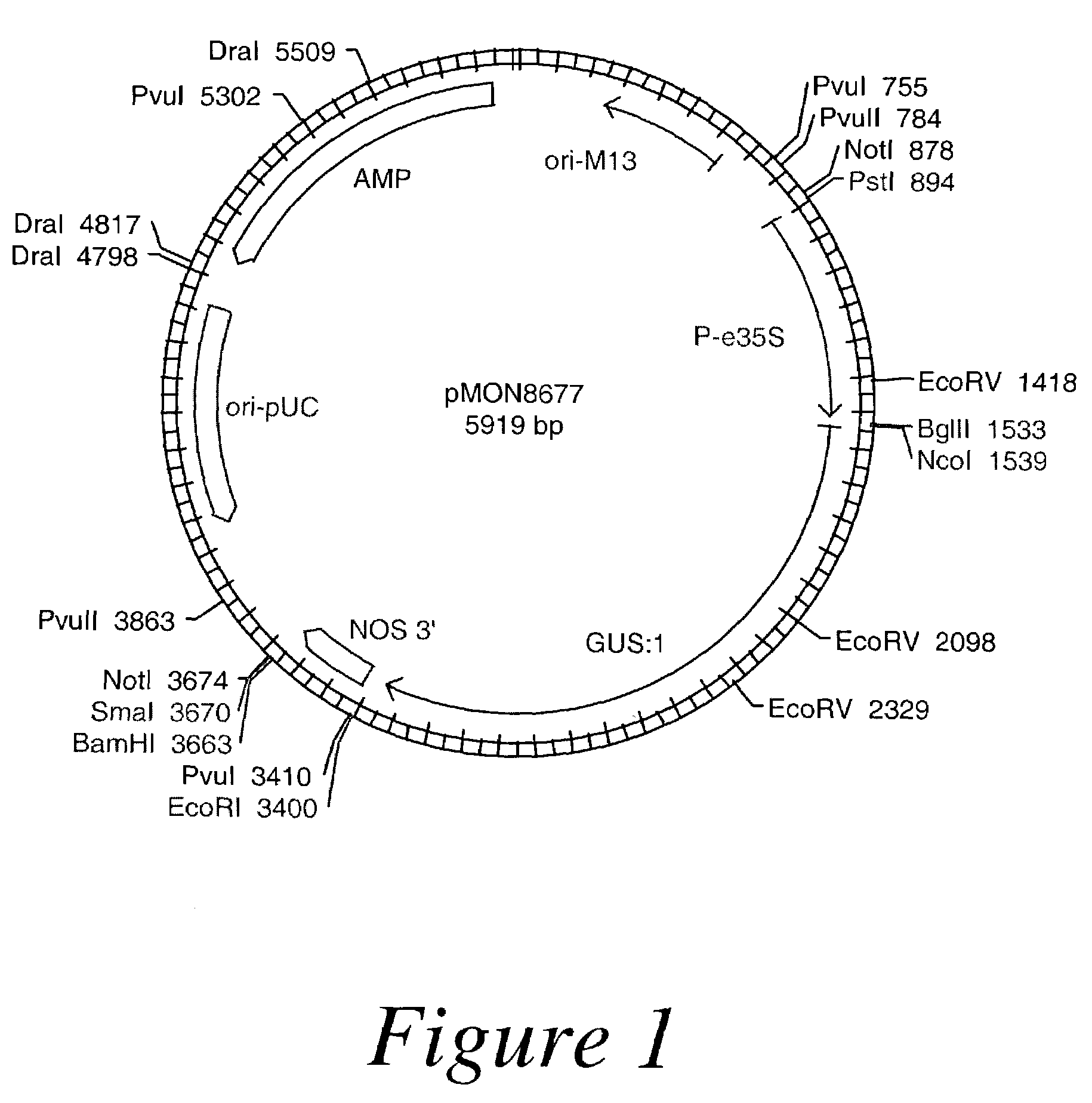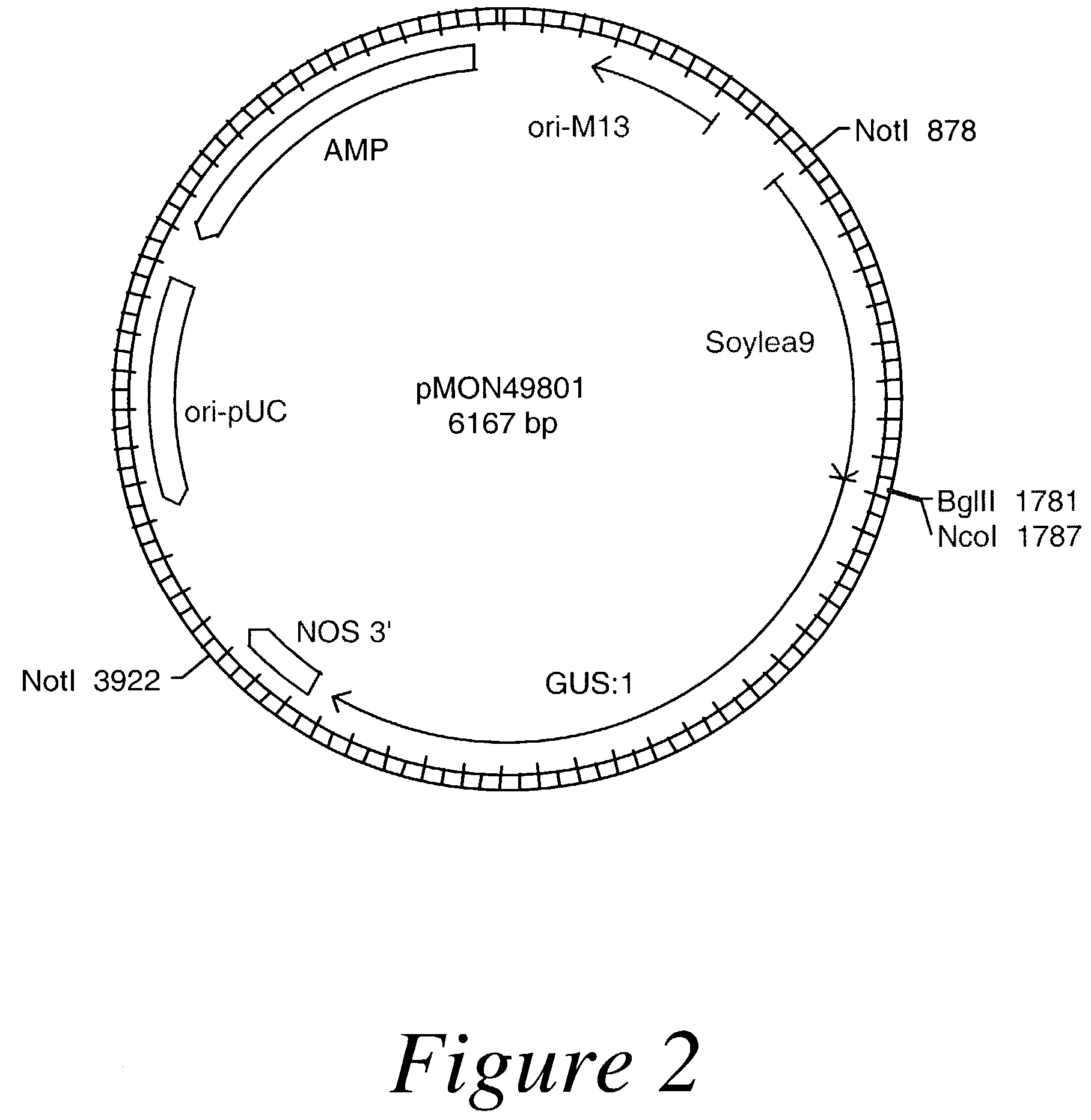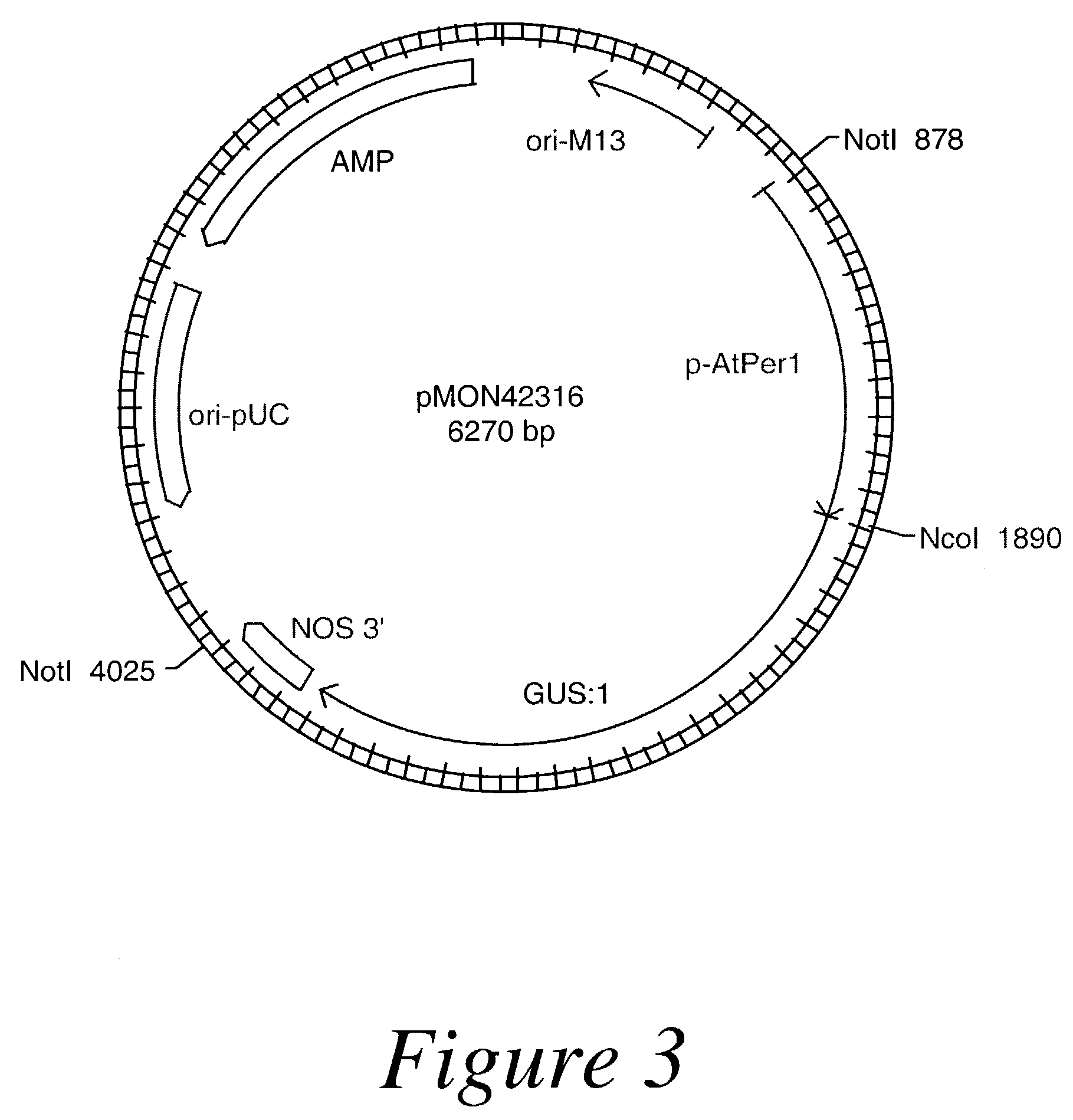Temporal seed promoters for expressing genes in plants
a technology of seed promoters and genes, applied in the field of plant genetic engineering, can solve the problems of affecting plant growth and development, and affecting plant growth and development, and may need to be limited to the desired targ
- Summary
- Abstract
- Description
- Claims
- Application Information
AI Technical Summary
Benefits of technology
Problems solved by technology
Method used
Image
Examples
example 1
[0204]The promoter for the soybean lea9 gene (Hsing, et al., Plant Physiol., 100:2121–2122 (1992)) is PCR amplified from soybean genomic DNA (cv. Asgrow 4922) using the following primers based on the published sequence:
[0205]
Primer ID lea9-5′(SEQ ID NO: 5)5′-ACCTGCGGCCGCCAAGTACTTACGCCACACCAACTTAC-3′; andPrimer ID lea9-3′(SEQ ID NO: 6)5′-GCAGCTGTTTCCTTGATGGACTCTC-3′.
[0206]All oligonucleotide primers are obtained from Gibco Life Technologies (Grand Island, N.Y.). The initial PCR reaction is performed using the Taq DNA polymerase kit (Boehringer Mannheim, Germany). The nested PCR reaction follows the primary PCR reaction, using the 5′ primer of the initial reaction and lea9-3′nest′ (GAAGATCTCCTGCAATTTCAAAGATC AATTATTTCC) (SEQ ID NO: 7). The following tables summarize the components used for these reactions:
[0207]
ComponentAmountINITIAL PCR REACTIONSoybean Genomic DNA (80 ng / μl)1.0 μldNTP mix (10 mM of each dNTP)1.0 μlPrimer lea9-5′ (10 μM)1.0 μlPrimer lea9-3′ (10 μM)1.0 μl10X PCR Buffer...
example 2
[0211]The promoter for the Arabodpsis thaliana per 1 gene (Haslekas, et al., Plant Mol. Biol. 36:833–845 (1998)) is PCR amplified from Arabidopsis (cv. Columbia) genomic DNA using the following primers designed from the published gene sequence:
[0212]
Primer ID JA445′-GGATCCAAATCAAAGTTTAATAGACTT-3′;(SEQ ID NO: 8)andPrimer ID JA465′-TCTAGGTTCGGCACCGTGTCTC-3′.(SEQ ID NO: 9)
[0213]The oligonucleotide primers are supplied by Gibco Life Technologies (Grand Island, N.Y.). The PCR is performed with the Expand High Fidelity PCR System (Boehringer Maniheim, (Germany), catalog number 1732641). Following the primary PCR reaction, a second reaction using nested PCR primers is performed using 1 μl of product from the primary reaction and the following primers designed from the published sequence:
[0214]
Primer ID JA45(SEQ ID NO: 10)5′-TAGCGGCCGCTAATAGACTTTGCACCTCCAT-3′; andPrimer ID JA47(SEQ ID NO: 11)5′-AACCATGGTTTACCTTTTATATTTATATATAGAA-3′.
[0215]The PCR components and conditions are outlined below:...
example 3
[0220]The promoter for the soybean Sle2 gene (Calvo, et al., Theor. Appl. Genet., 94:957–967 (1997)) is amplified from the a soybean genomic DNA library (cv. Williams 82, purchased from Stratagene, La Jolla, Calif.; cat. number 946103). The following primers, which are designed from the published gene sequence, are used for the primary reaction:
[0221]
Primer ID JA415′-GTGTTACATTATCACTTATCCTGGTC-3′;(SEQ ID NO: 13)andPrimer ID Jeahre25′-GCTCAATTAACCCTCACTAAAGGGA-3′.(SEQ ID NO: 14)
[0222]The oligonucleotide primers are supplied by Gibco Life Technologies (Grand Island, N.Y.). The primary PCR reaction is performed with the Expand Long Template PCR system (Boehringer Mannheim, Germany, catalog number 1681834).
[0223]Following the primary PCR reaction, a nested PCR reaction is performed using 1 μl of product from the primary reaction as template DNA and the following nested primers designed from the published sequence:
[0224]
Primer ID JA435′-CTCTTGAGCACGTTCTTCTCCT-3′; and(SEQ ID NO: 15)Primer...
PUM
| Property | Measurement | Unit |
|---|---|---|
| temperatures | aaaaa | aaaaa |
| volume | aaaaa | aaaaa |
| volume | aaaaa | aaaaa |
Abstract
Description
Claims
Application Information
 Login to View More
Login to View More - R&D
- Intellectual Property
- Life Sciences
- Materials
- Tech Scout
- Unparalleled Data Quality
- Higher Quality Content
- 60% Fewer Hallucinations
Browse by: Latest US Patents, China's latest patents, Technical Efficacy Thesaurus, Application Domain, Technology Topic, Popular Technical Reports.
© 2025 PatSnap. All rights reserved.Legal|Privacy policy|Modern Slavery Act Transparency Statement|Sitemap|About US| Contact US: help@patsnap.com



